
![]()
T-2 Tanker
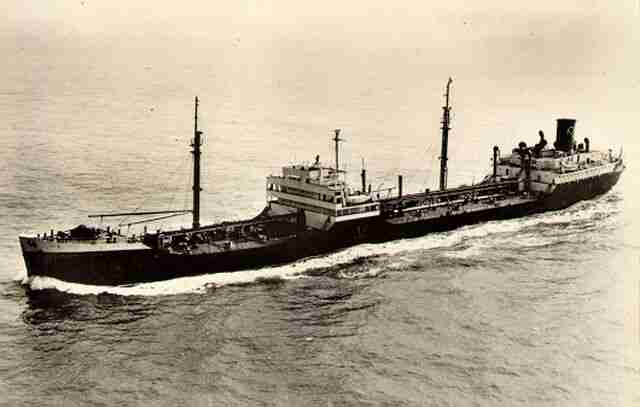
This is the ms Woensdrecht and is an example of a surplus ex-wartime T-2 tanker. The ship was built in 1945 and decommissioned in 1962. Gross tonnage: 10.935. Overall length: 154 m. Service speed: 14 knots. Maximum speed: 17 knots. The Woensdrecht and Wieldrecht (1944) were sister ships.
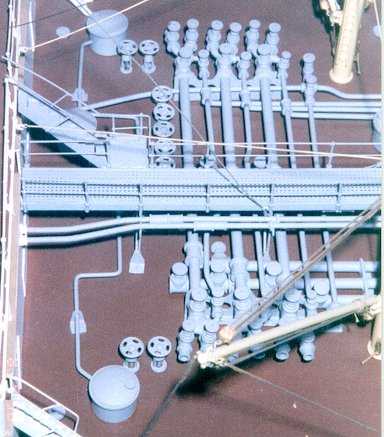
The neat layout of the manifold of a T-2 tanker. Nice paint job! In Dutch it was often jokingly called 'Malieveld', which is a green area in the city of The Hague, NL.
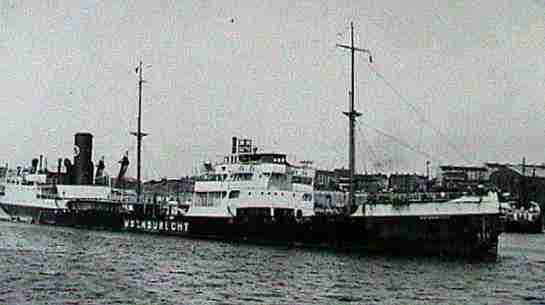
The old ms Woensdrecht was torpedoed in 1942 by a German U-boat.
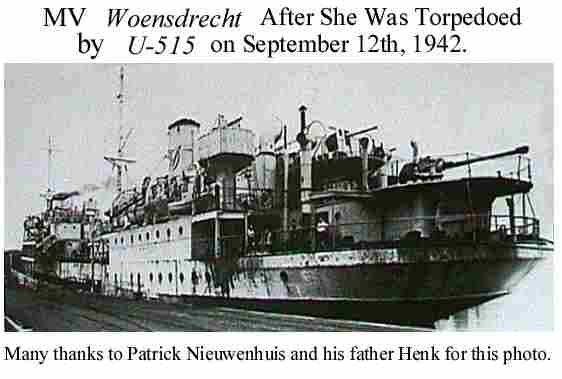
Note the canon mounted on the
aft deck and the anti aircraft gun a little to the left and up, also a third
gun, as it looks, a bit more to the left. Probably the same time of gun was also
installed on the starboard side of the ship. Gross tonnage: 4,668.
Date of Attack: September 12th, 1942. Position of Attack: 10° 27 N., 60° 17 W. (Caribbean Sea, off Trinidad).
The ms Woensdrecht was en route from Matadi, Belgium Congo, (now Democratic Republic of Congo) to Takoradi, Gold Coast, (now Ghana) to Trinidad, in ballast, when she was torpedoed four times by the
U-boat U-515. Fortunately, her crew of 34 and 4 gunners were all saved. The forepart of the ship remained afloat and was towed to Trinidad on September 19th, but it was not repairable.
http://www.geocities.com/CapeCanaveral/Campus/3415/t2tanker.html The T-2 Tanker page. Worth looking at.
Several hundred turbo electric drive tankers of this design were built during World War II. Construction of the vessels was standardized to meet Uncle Sam's need for maximum production during the period 1942 - 1945. The T-2 served as the backbone of the tanker industry for many years. A T-2 tanker was built for easy handling by the crew. The manning of all the hundreds of T-2 tankers and also the 2700 Liberty freighter ships was a difficult thing. Rather inexperienced crews had to handle these - for those days - big ships.
T-2's and Liberty's (the Ugly Duckling) which was based on the earlier Ocean Class design, were conceived with three things in mind: "minimum cost, rapidity of construction, and simplicity of operation." To reach the last mentioned goal the propulsion system of the T-2 tankers was laid in such a way as to reflect this requirement. A big electric generator was driven by the constant speed turbine engines. The generator's electric output was coupled to an electric motor which in turn was coupled to the propulsion shaft. On the end of the shaft was the single screw. The ship's speed could be easily electrically controlled by the throttle board which was part of the Westinghouse propulsion control cubicle. Thus controlling the ship's speed was reduced to handling a throttle like on a car! Things could not get much easier in a ship's engine room. By the way, electric propulsion is the thing today. Almost all new built cruise ships, like for instance the latest Holland America Liner 'Amsterdam', have such an electric Azipod propulsion system. So that proofs how advanced this propulsion system really was in those WII-days!
The most obvious technical change in building Liberty ships was the use of Marine welding rather than riveting, which reduced both construction time and cost. Liberty ships constructed in the US totalled 2, 710.The Liberty ships were built in an absolute record time. The production process can be best compared a very efficient chicken breeding machine. Astoundingly, the Kaiser shipyard in Oakland, built the Liberty Ship S.S. Robert Peary, from keel laying to launching, in 4 days 15 hours and 30 minutes. It was then outfitted, painted, taken on sea trials, the crew was trained and the vessel fully loaded with 10,000 tons of cargo. The Peary sailed 7days after the keel was laid! How about that?
The original specifications of a T-2 tanker looked like this:
Displacement: 21,077 tons
Length: 502'
Beam: 58'
Draft: 31'
Speed: 17 knots (max); 13 knots (econ)
Armament: 1 5"/38 DP, 4 3"/50 DP, 4x2 40mm, 4x2 20mm
Complement: 243
Capacity: 134,000 barrels
Geared turbine engines, single screw, 12,000 hp
Maritime Commission T2 (MC-SO) type
http://home.pacbell.net/corwind/Crew.html This web site describes the dramatic disappearance of an adapted T-2 tanker, the
SS Marine Sulphur Queen
in the Bermuda triangle in one day early in February in 1963 with the loss of all 39 crew members. Despite extensive efforts to explain the mysterious disappearance it was never established what actually had happened. The ship was on a voyage from Beaumont, Tex., to Norfolk, Va., with a cargo of hot sulphur.
http://www.hazegray.org/shipbuilding/quincy/ Fore River Shipyard
http://home.pacbell.net/corwind/msqnews.html Marine Sulphur Queen disappeared in Bermuda Triangle
http://www.rmstitanichistory.com/msq/msq.html Marine Sulphur Queen last heard from, February 4, 1963
http://www.mysteries-megasite.com/main/bigsearch/bermuda-2.html Bermuda Triangle Database
The Wartime and Post Wartime Asbestos Tragedy
The price for building ships in those number has proven to be very high. It is a tragedy that the wartime shipbuilding industry had created the asbestos monster. In 1879, when workers tore open the earth at the world's first commercial asbestos mine in the Appalachian foothills of Quebec, they unknowingly released a geological genie of death. Asbestos' ability to withstand high temperatures and corrosion made it an ideal material for heat isolation purposes in shipbuilding. For much of the 20th century, efforts to put the genie back into the bottle were thwarted by an asbestos industry that knew of the dangers of its commodity but constructed an elaborate conspiracy of silence. Governments like the Dutch and U.S. government, which also knew asbestos was hazardous turned a blind eye to the dangers throughout most of the 20th century. World War II ushered in a Navy shipbuilding effort the likes of which the world had never seen and likely will never see again. The American fleet grew from 394 vessels in 1939 to 6,768 in 1945 -- a 17-fold increase in six years. More than 4 million men and women heeded the call to build and repair that vast fleet. The wartime shipbuilding boom created unprecedented demand for asbestos. Its ability to withstand high temperatures and corrosion and its relative abundance in nature made asbestos the ideal material to insulate the vessels' heat-producing components.
Many thousands of metric tons of the fibrous mineral were used to wrap the pipes and line the boilers, engines and turbines of the ships needed to carry men and munitions into theatres of war in Europe and Asia. But just as the shipbuilding boom had begun, troubling news about asbestos spread: The inhalation of its microscopic fibres caused workers in Europe to fall sick and sometimes die. As that news found its way into medical journals, U.S. Navy health officials became alarmed. In 1943, the U.S. government issued standards intended to protect a shipyard work force that laboured 24 hours a day, seven days a week in massive fogs of asbestos dust.
But more than three decades would pass before the government would begin enforcing those standards and take steps to protect workers. It wouldn't be until the late 1970s that documents surfaced in court, proving that industry officials knew of the dangers of asbestos and tried to conceal them.Today, current and former shipyard workers and their families are paying a high price. In Hampton Roads alone, thousands have been sickened or killed, and many more will succumb as asbestos disease continues to manifest itself well into the 21st century.
The Navy looked at the shipyard workers as though they were 'front-line troops'' during World War II. In fact, working in an American shipyard during World War II would prove to be almost as deadly as fighting in the war.During World War II, 16.1 million Americans were called to arms. The combat death rate was about 18 per thousand service members. About 4.3 million Americans worked in shipyards during the war. For every thousand wartime shipyard employees, about 14 died of asbestos-related cancer, and an unknown number died of an asbestos disease called asbestosis, or complications from it.
Now, in the third century of the asbestos tragedy, an average of one American per hour dies of workplace exposure to the mineral once prized for its flame-resistant quality. They are the victims of a cover-up that rivals that of Big Tobacco. But these victims didn't know they were being poisoned.Latest Dutch new about asbestos victims payment
On August 22, 2002 Dutch newspapers report that more than 90 percent of the Dutch asbestos victims, who are entitled to damage payments, die before the day that the damage payment has been received. The victims, mostly men who contracted a serious asbestos induced illness of which mosothelioom is the most deadly one, during their working life almost never receive the satisfaction and recognition of their ill fate in terms of damage payments. In Holland the victims, as soon as their disease is shown, can register a claim with the Institute of (Dutch) Asbestos Victims (IAS) for damage payments. The institute then intermediates between the victims and their former employers. If the employer has gone bankrupt or disappeared in the mean time the victims can then call on the Social Security Bank via the IAS for damage payments. The IAS was instituted at the beginning of 2000 in order to end the legal tragedy of the asbestos victims. From a interim report of Price Waterhouse Coopers, who judged the new system by an order of the Ministry of Social Affairs, it was shown that the handling times of seven or months and more are quite usual. The lawyers of the Committee for Asbestos Victims state that the government does not uphold their promises. The new damage payment system is an empty shell and window dressing only as it has not contributed in any way to end the legal misery of the victims and their families. In Holland - as an estimate - every year 350 new mesothelioom victims can be added to the long list. The burocrats have won again as they always seem to do. We are home to all the drug dealers in the world it seems, a safe haven to all kinds of terrorists, by far the biggest exporting country of XTC-pills etc etc, permitting sales of soft and hard drugs, allowing the streets in the big cities to be taken over by criminals, owners of a luxury prison system with one person cells with radio, television and a private bathroom and every thinkable recreational facility available, but we do not seem to be able to pay respect and proper tribute to those who suffered from a disease already known for a long time. As stated above also the Dutch are the victims of a cover-up that rivals the one created by the tobacco industry. And we have a government who could not care less, except for their own well being and keeping their own precious jobs circuit fully in tact, the Old Boys Network. But then every country deserves the kind of government is has.
Luxury Prison System
Today, Friday April 9, 2004, the Dutch public learnt from the newspapers that prisoners in our penitentiary system - already since many years - can watch at their leisure the Canal+ pay TV channel, both in the recreational areas as in their private cells. Like in the better hotels they can pick any program from porn to the live football games and the latest exclusive movies. Newspapers editors complain in their articles that Dutch prisoners have more recreational facilities and now also more television channels to monitor, than the average hard working Dutchman. And gallantly paid for by that same naive Dutchman who is heavily taxed to maintain all these privileges and similar absurdities. During the last couple of years more and more people are beginning to awaken and starting to protest, asking for a downgrading of prison facilities of which the Canal+ is a bitter example. Many of the elderly and senior citizens, who had to work hard all their lives to earn a simple level of comfort, live now under lesser circumstances than prisoners in their ultra modern, high cost facilities. Playing cards and shooting pool with the guards.
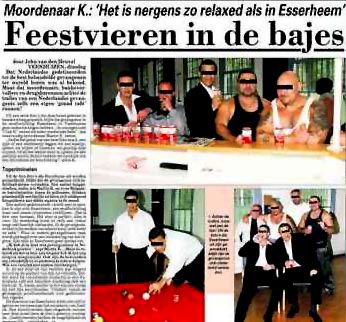
A recent (September 2005) newspaper article describes the favourable living conditions in one of our so called prison facilities. The uppermost text reads: Murderer K.: 'Nowhere it is so relaxed as in Esserheem' The latter being the prison's name. He candidly continues saying that also the guards are so very nice and helpful towards the inmates. Next in big lettering: Having a feast in jail. The pictures show some details of this eerie party. The beer at the bar is Amstel brand. Among the exquisite party food one could find Japanese Sushi and plenty of Sake to wash it down with. We have in our country the funny habit of making the inmates faces unrecognisable as not to violate their privacy! For the same reason it says 'Murderer K.' as it is by law also not allowed to print the name of a suspect or criminal in full. We have to read their names in foreign newspapers who are less shy. Shocking in the article was the mentioned fact that apart from a swimming pool also tennis courts are at the disposal of the 'guests'. Everything at the taxpayer's expense off course. How foolish can you get and what a shame it is to every normal thinking Dutchman.
TBS system
The penitentiary system here in Holland still has more surprises in stock. We have a system called TBS which means something like "put at the disposal of the government". The heavyweight criminals who are in the program are the cream of the crop so to speak and mentally ill according to the judge who convicted them. Due to their mental condition they cannot be held responsible for their crimes is the judge's and government's opinion. Therefore they are not punished in the normal way to a lengthy stay in a low down jail but instead they are 'convicted' to a special institution in which they are treated with the intention to return these unguided missiles to society as soon as possible. Murderers are for instance allowed already soon to go on weekend furlough, in the beginning accompanied by two guards! That is because it is supposed to be good for the self confidence and at the same time they can get used again to normal society. Think alone of the costs to realise this extravagancy. A lot of them escape during these outings outside the institution and some - like during this summer of 2005 - immediately start to murder again. Within a couple of days after his escape from a single female staff member during an outside furlough, authorised by the Veldzicht clinic, he hammered a 73 year old male citizen to death. The responsible Justice Department Minister, when asked by parliament about this incidents and a number of others, maintains that nothing wrong with the system and that these are isolated incidents, a kind of collateral damages which society must accept, alas. Of course the politicians being politicians are satisfied with this explanation. It is al part of the trade.
The inmates often outsmart the staff and are masters at 'acting very normal' so to acquire one privilege after the other. Most of them surprisingly find enough women to marry them through active advertising in some weekly magazines. Some maintain intimate relations with up to four women in this way. Even if not married these women are allowed to spend nights with the inmates in the institution. It also helps them to get out much earlier due to such a relation, as they are not considered to be 'stable'.
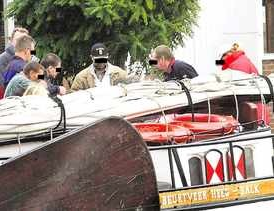
On 29th of September 2005 a Dutch newspaper got wind of a special sailing trip with six inmates of the ill famous long stay department of the Veldzicht clinic. Without any guards being present during the trip. That would probably only undermine their self esteem. Amongst them for good measure was a double murderer. Probably the staff brainstormed before on how to surprise the inmates this time again with something completely different. A sailing trip in a traditional 'skūtsje' sailboat in Friesland in the northern part of our country would be just the nice surprise for the good old boys. The clinic and the government denied that any such outing had taken place, but confronted with the newspaper's overwhelming photo evidence they had to admit and now suddenly declared that they had been familiar with the sailing trip and that all it was well within the existing rules. So we do not have to worry.
Nobody can explain this any more to the public. Only the government and politics who created this anomaly seem to be able to understand it and thus sanction it. But then, the government and most politicians have drifted - since many years already - far, far away from what goes on in the public's mind and heart.
Grow shops
As the result of our luxury prison system, our funny law system and the lenient attitude of the justice department towards criminal activities, all kinds of unwanted elements are drawn as by a magnet to our country. Also some of the locals often take calculated risks as the penalties for crimes are mild anyway. A sad example of our soft system is the existence of the so called grow shops. Here you can buy all the necessary equipment like lamps, ventilators to set up a cannabis, marihuana or weed plant in your spare room, cellar or attic. And this is fully legal too! The grow shop is not allowed to sell the weed plants, but they have addresses, often next-door neighbours, who can supply plants to order. The grow shop also provide instructions how to by pass the electricity meter. Further Dutch web sites provide all necessary instructions. The estimated number of private weed growers is between 25.000 and 30.000 The craziness of our system is that it is illegal to grow weed plants, not to sell the equipment. Also the so called coffee shops are allowed to sell weed to their customers. The allowed maximum amount per coffee shop is 500 grams. However, they our not allowed to buy weed at the back door to compensate for their sales! Hello, can you still follow me? So they have to purchase the weed in the stealth mode. As long as they are not caught in the act they are in business. The police only occasionally makes a small effort to catch them buying weed. When a weed plantation is found the equipment and plants are confiscated and the owners only get a fine. That's all. Well, they are the small fry anyway. They also can look forward to a bill of the electricity company for stolen power. They make up a bill according to the number of lamps and plants found and they make an estimate of how long the plantation has been in use.
Click on the animated picture for a grow shop's web site
All this has made us to the laughing stock of Europe and the world but the government maintains that this is a very sound government policy. At this moment the yearly production of weed is estimated to be 438.000 kg and the turn over is twice that of our total national milk production sector. What is confiscated is really peanuts compared to that figure.
Links:
http://www.elslaw.com/jobsites_ca_todd2.htm Asbestos Industry
http://www.geocities.com/CapeCanaveral/Campus/3415/t2tanker.html
http://www.marinelog.com/DOCS/cen4.html
http://www.scheepvaartvangerrit.nl
Dutch language website about ms Woensdrecht: Interesting is that the web site's owner by the name of Gerrit, mentions the fact that he was one of the crew members that brought the ms Woensdrecht to the demolition yard in Taipei on the island of Taiwan. The last trip brought the ship first to Carapito in Venezuela and then via the Panama Canal to Yokohama in Japan and then the last leg of the trip to Taiwan. How the Taiwanese managed the asbestos problem during the scrapping of the vessel remains a secret.....
